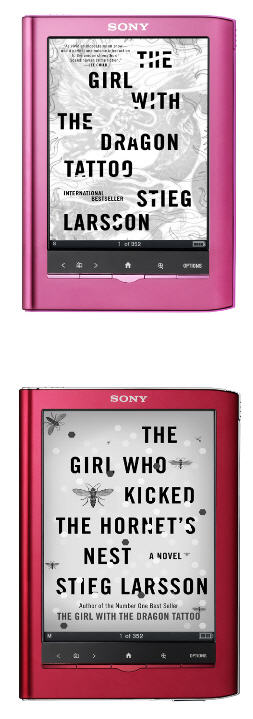Sony's latest e-readers: Understanding the trade-offs and global strategy

Sony's new e-readers are a vast improvement over its previous versions. The latest Sony Readers are lighter, show off touch navigation on an E-Ink screen and could be worthy choices in the e-reader wars vs. Amazon and Barnes & Noble. But there are trade-offs in the devices that could pay off---or blow up---for Sony.

The biggest trade-off here---at least for connected U.S. consumers---is the touch vs. connectivity choice. For instance, Sony gives you touch navigation, but its Pocket and Touch readers don't off Wi-Fi or 3G connectivity. Steve Haber, president of Sony's digital reading division, says that the company's research shows that most customers tether their devices. When I asked Haber whether Sony was risking a confirmation bias---customers are tethering because that's the only way to connect---and he acknowledged that there's a risk.
When Sony set out to make its e-readers, it had an interesting mix of features to balance. For starters, Sony has the only e-reader among the big three that have real touch. Barnes & Noble's Nook has touch navigation on a little strip, but Sony's e-readers allow you to swipe to turn the page.
Also: Sony launches new e-readers; Will pricing matter?
When I took Amazon's latest Kindle for a spin, I was told that there were too many compromises with touch navigation. In a nutshell, touch had latency because the signal sent by your fingers had to go through two planes---glass and the E-ink. Sony, however, eliminated the need for an overlay screen. Now touch is much more intuitive and works well.
Sony's E-Ink touch navigation is a real difference maker. It took some getting used to, but worked well overall.
But Sony doesn't quite close the deal. Why? Its touch readers don't do Wi-Fi. And then Sony has higher price points. Sony's highest end reader has a 7-inch screen, 3G and Wi-Fi, but will set you back $299. The mid-range Touch, which Haber is betting will be its most popular unit, goes for $229. The Sony Pocket Reader will run you $179. It has touch navigation and a 5-inch screen. Of course, you have to tether.
Add it up and you have these moving parts:
- Amazon will give you the 3G and Wi-Fi with its $189 Kindle. However, there's no touch. A Wi-Fi Kindle is $139.
- Barnes & Noble has a Wi-Fi Nook for $149. Barnes & Noble gives you some touch navigation, but there is a latency issue with its Android implementation.
- Sony gives you touch navigation has higher price points, but you have to tether. Instead of plastic casing you get brushed aluminum in various colors.
Simply put, if you're shopping for an e-reader Sony's devices will largely win or lose based on how you weigh touch vs. connectivity. I'm assuming that Sony's Daily Reader won't be a huge win at $299.
Haber acknowledges the risks, but says Sony was giving the best device at a good price. He says that a Wi-Fi, 3G chip would have bumped up the prices for the Touch and Pocket readers. "Wi-Fi would have raised the cost when 99 percent of the time spent with an e-reader is focused on just reading," says Haber. "We invested in the best possible screen experience. That's where we put our dollars/yen."
Now Sony could be wrong with its trade-off guesses. Haber notes that Sony has a habit of being 5-years too early on trends---a comical reference to the launch of e-readers in 2003.
Playing for the globe
Why would Sony make such trade-offs between touch and connectivity? Sony is playing a global game and perhaps 3G and Wi-Fi just doesn't matter as much in Spain, Japan and China. Haber in Sony's statement reveals the company's strategy.Haber said that Sony is launching in "the countries we already serve" but also expanding into "previously untapped markets." He added that Sony takes "a thoughtful approach to country expansion, including Italy, Spain, Australia, Japan and China, working with local bookstores to ensure content is compatible, relevant and in the appropriate language for each market.”
In the U.S. it won't be hard to find techies to pan the Sony Reader trade-offs. How can a reader not have Wi-Fi?
However, there's a big picture here---and its global. In our 75 minute conversation, Haber mentioned global reach a bunch of times. The Reader carries global dictionaries in various languages. Sony is plotting China, Europe and a bevy of emerging markets for its Reader.
Sony, widely assumed to be No. 2 in the e-reader market behind Amazon, could be playing to be Nokia. Nokia is big everywhere around the globe except the U.S.
Sony's situation won't be that dire. Sony will be a player in the U.S., but the real win will be in places like Russia, Brazil and China. Why? Sony's brand carries a lot of weight. And Sony has the retail partnerships that wrap around the globe.
Meanwhile, Amazon and Barnes & Noble will be hard-pressed to replicate Sony's global reach. If the global trend is to move away from paper to bits of data the e-reader market worldwide is just beginning. Sony can be everywhere its primary rivals can't. Meanwhile, Sony's real rivals---companies like Samsung---don't have e-readers or the content that needs to ride shotgun. Sony's store is comparable to the others and has seen its 10 millionth book download.
So let's sum up:
- Sony has distribution;
- Credible and improving e-readers;
- And a truly global brand.
Sony won't downplay the U.S. market totally, but it's clear the company is eyeing a larger e-reader stage---the globe.